Diterpenoids Isolated from Podocarpus macrophyllus Inhibited the Inflammatory Mediators in LPS-Induced HT-29 and RAW 264.7 Cells
Abstract
1. Introduction
2. Results
2.1. Bioactivity-Guided Isolation of Constituents from the Leaves of P. macrophyllus
2.2. Structural Elucidation of Isolates 1–4
2.3. Biological Evaluation of Isolates 1–4
2.3.1. NO Production Inhibitory Effect and Cytotoxicity of Isolates 1–4
2.3.2. Effects of Nagilactone B on LPS-Induced iNOS and COX-2 Expression
2.3.3. Effects of Nagilactone B on LPS-Induced pERK 1/2 Expression
2.3.4. Effects of Nagilactone B on LPS-Induced Proinflammatory Cytokines Production
3. Discussion
4. Materials and Methods
4.1. General Procedures and Chemical Regents
4.2. Plant Materials
4.3. Extraction and Isolation
4.4. ABTS and DPPH Radicals Scavenging Assay
4.5. Cell Culture and Cell Viability
4.6. NO Assay
4.7. Enzyme-Linked Immunosorbent Assay (ELISA)
4.8. Western Blot
4.9. Statistical Analysis
5. Conclusions
Supplementary Materials
Author Contributions
Funding
Institutional Review Board Statement
Informed Consent Statement
Data Availability Statement
Conflicts of Interest
Sample Availability
References
- Baumgart, D.C.; Carding, S. Inflammatory bowel disease: Cause and immunobiology. Lancet 2007, 369, 1627–1640. [Google Scholar] [CrossRef]
- Ramos, G.P.; Papadakis, K.A. Mechanisms of disease: Inflammatory bowel diseases. Mayo Clin. Proc. 2019, 94, 155–165. [Google Scholar] [CrossRef] [PubMed]
- Lee, J.M.; Lee, K.-M. Endoscopic diagnosis and differentiation of inflammatory bowel disease. Clin. Endosc. 2016, 49, 370–375. [Google Scholar] [CrossRef]
- Lopez, J.; Grinspan, A. Fecal microbiota transplantation for inflammatory bowel disease. Gastroenterol. Hepatol. 2016, 12, 374–379. [Google Scholar]
- Kaulmann, A.; Bohn, T. Bioactivity of polyphenols: Preventive and adjuvant strategies toward reducing inflammatory bowel diseases promises, perspectives, and pitfalls. Oxidative Med. Cell. Longev. 2016, 2016, 9346470. [Google Scholar] [CrossRef] [PubMed]
- Joung, E.-J.; Lee, B.; Gwon, W.-G.; Shin, T.; Jung, B.-M.; Yoon, N.-Y.; Choi, J.-S.; Oh, C.W.; Kim, H.-R. Sargaquinoic acid attenuates inflammatory responses by regulating NF-κB and Nrf2 pathways in lipopolysaccharide-stimulated RAW 264.7 cells. Int. Immunopharmacol. 2015, 29, 693–700. [Google Scholar] [CrossRef]
- Kwon, S.H.; Gurtner, G.C. Is early inflammation good or bad? Linking early immune changes to hypertrophic scarring. Exp. Dermatol. 2017, 26, 133–134. [Google Scholar] [CrossRef]
- Wang, N.; Liang, H.; Zen, K. Molecular mechanisms that influence the macrophage M1–M2 polarization balance. Front. Immunol. 2014, 5, 614. [Google Scholar] [CrossRef]
- Vane, J.R.; Bakhle, Y.S.; Botting, R.M. Cyclooxygenases 1 and 2. Annu. Rev. Pharmacol. Toxicol. 1998, 38, 97–120. [Google Scholar] [CrossRef]
- Coscelli, G.; Bermúdez, R.; Ronza, P.; Losada, A.P.; Quiroga, M.I.; García, A.P.L. Immunohistochemical study of inducible nitric oxide synthase and tumour necrosis factor alpha response in turbot (Scophthalmus maximus) experimentally infected with Aeromonas salmonicida subsp. salmonicida. Fish Shellfish Immunol. 2016, 56, 294–302. [Google Scholar] [CrossRef]
- Félétou, M.; Köhler, R.; Vanhoutte, P.M. Nitric oxide: Orchestrator of endothelium-dependent responses. Ann. Med. 2011, 44, 694–716. [Google Scholar] [CrossRef]
- Foürstermann, U.; Sessa, W.C. Nitric oxide synthases: Regulation and function. Eur. Heart J. 2012, 33, 829–837. [Google Scholar] [CrossRef]
- Khan, S.; Shehzad, O.; Jin, H.-G.; Woo, E.-R.; Kang, S.S.; Baek, S.W.; Kim, J.; Kim, Y.S. Anti-inflammatory mechanism of 15,16-epoxy-3α-hydroxylabda-8,13(16),14-trien-7-one via inhibition of LPS-induced multicellular signaling pathways. J. Nat. Prod. 2012, 75, 67–71. [Google Scholar] [CrossRef]
- Abdillahi, H.; Finnie, J.; Van Staden, J. Anti-inflammatory, antioxidant, anti-tyrosinase and phenolic contents of four Podocarpus species used in traditional medicine in South Africa. J. Ethnopharmacol. 2011, 136, 496–503. [Google Scholar] [CrossRef]
- Sato, K.; Sugawara, K.; Takeuchi, H.; Park, H.-S.; Akiyama, T.; Koyama, T.; Aoyagi, Y.; Takeya, K.; Tsugane, T.; Shimura, S. Antibacterial novel phenolic diterpenes from Podocarpus macrophyllus D. DON. Chem. Pharm. Bull. 2008, 56, 1691–1697. [Google Scholar] [CrossRef]
- Kim, Y.J.; Kang, K.S.; Yokozawa, T. The anti-melanogenic effect of pycnogenol by its anti-oxidative actions. Food Chem. Toxicol. 2008, 46, 2466–2471. [Google Scholar] [CrossRef] [PubMed]
- Shim, S.-Y.; Lee, Y.E.; Song, H.Y.; Lee, M. p-Hydroxybenzoic acid β-D-glucosyl ester and cimidahurinine with antimelanogenesis and antioxidant effects from Pyracantha angustifolia via bioactivity-guided fractionation. Antioxidants 2020, 9, 258. [Google Scholar] [CrossRef]
- Ying, B.-P.; Kubo, I. Complete 1H and 13C NMR assignments of totarol and its derivatives. Phytochemistry 1991, 30, 1951–1955. [Google Scholar] [CrossRef]
- Chen, G.; Li, X.; Saleri, F.; Guo, M. Analysis of flavonoids in Rhamnus davurica and its antiproliferative activities. Molecules 2016, 21, 1275. [Google Scholar] [CrossRef]
- Amaro-luis, J.M.; Amesty, A.E.; Montealegre, R.; Bahsas, A. Rospiglioside, a new totarane diterpene from the leaves of Retrophyllum rospigliosii. J. Mex. Chem. Soc. 2006, 50, 96–99. [Google Scholar]
- Hayashi, T.; Kakisawa, H.; Ito, S.; Chen, Y.P.; Hsū, H.-Y. Structure of the further norditerpenoids of Podocarpus macrophyllus. Inumakilactone a glucoside, a plant growth inhibitor and inumakilactone E. Tetrahedron Lett. 1972, 13, 3385–3388. [Google Scholar] [CrossRef]
- Faiella, L.; Temraz, A.; Siciliano, T.; De Tommasi, N.; Braca, A. Terpenoids from the leaves of Podocarpus gracilior. Phytochem. Lett. 2012, 5, 297–300. [Google Scholar] [CrossRef]
- Matsumoto, T.; Imai, S.; Yoshinari, T. The synthesis of (15R)-coleon C and (15S)-coleon C. Bull. Chem. Soc. Jpn. 1987, 60, 2435–2443. [Google Scholar] [CrossRef]
- Matsumoto, T.; Imai, S.; Yoshinari, T. The syntheses and absolute configurations of Nellionol and 5-Dehydronellionol. Bull. Chem. Soc. Jpn. 1985, 58, 1165–1170. [Google Scholar] [CrossRef]
- Hayashi, Y.; Takahashi, S.; Ona, H.; Sakan, T. Structures of Nagilactone A, B, C, and D, novel nor- and bisnorditerpenoids. Tetrahedron Lett. 1968, 9, 2071–2076. [Google Scholar] [CrossRef]
- Giustarini, D.; Rossi, R.; Milzani, A.; Dalle-Donne, I. Nitrite and nitrate measurement by griess reagent in human plasma: Evaluation of interferences and standardization. Methods Enzymol. 2008, 440, 361–380. [Google Scholar]
- Federico, A.; Morgillo, F.; Tuccillo, C.; Ciardiello, F.; Loguercio, C. Chronic inflammation and oxidative stress in human carcinogenesis. Int. J. Cancer 2007, 121, 2381–2386. [Google Scholar] [CrossRef]
- Reuter, S.; Gupta, S.C.; Chaturvedi, M.M.; Aggarwal, B.B. Oxidative stress, inflammation, and cancer: How are they linked? Free Radic. Biol. Med. 2010, 49, 1603–1616. [Google Scholar] [CrossRef]
- Feng, Z.-L.; Zhang, T.; Liu, J.-X.; Chen, X.-P.; Gan, L.-S.; Ye, Y.; Lin, L.-G. New podolactones from the seeds of Podocarpus nagi and their anti-inflammatory effect. J. Nat. Med. 2018, 72, 882–889. [Google Scholar] [CrossRef]
- Marletta, M.A.; Yoon, P.S.; Iyengar, R.; Leaf, C.D.; Wishnok, J.S. Macrophage oxidation of L-arginine to nitrite and nitrate: Nitric oxide is an intermediate. Biochemistry 1988, 27, 8706–8711. [Google Scholar] [CrossRef]
- MacMicking, J.; Xie, Q.-w.; Nathan, C. Nitric oxide and macrophage funtion. Ann. Rev. Immunol. 1997, 15, 323–350. [Google Scholar] [CrossRef]
- Castellano, I.; Ercolesi, E.; Palumbo, A. Nitric oxide affects ERK signaling through down-regulation of MAP kinase phosphatase levels during larval development of the Ascidian Ciona intestinalis. PLoS ONE 2014, 9, e102907. [Google Scholar] [CrossRef][Green Version]
- Galli, S.J.; Gordon, J.; Wershil, B.K. Cytokine production by mast cells and basophils. Curr. Opin. Immunol. 1991, 3, 865–873. [Google Scholar] [CrossRef]
- Kaminska, B. MAPK signalling pathways as molecular targets for anti-inflammatory therapy from molecular mechanisms to therapeutic benefits. Biochim. Biophys. Acta Proteins Proteom. 2005, 1754, 253–262. [Google Scholar] [CrossRef]
- Jo, A.; Kim, C.E.; Lee, M. Serratane triterpenoids isolated from Lycopodium clavatum by bioactivity-guided fractionation attenuate the production of inflammatory mediators. Bioorganic Chem. 2020, 96, 103632. [Google Scholar] [CrossRef]

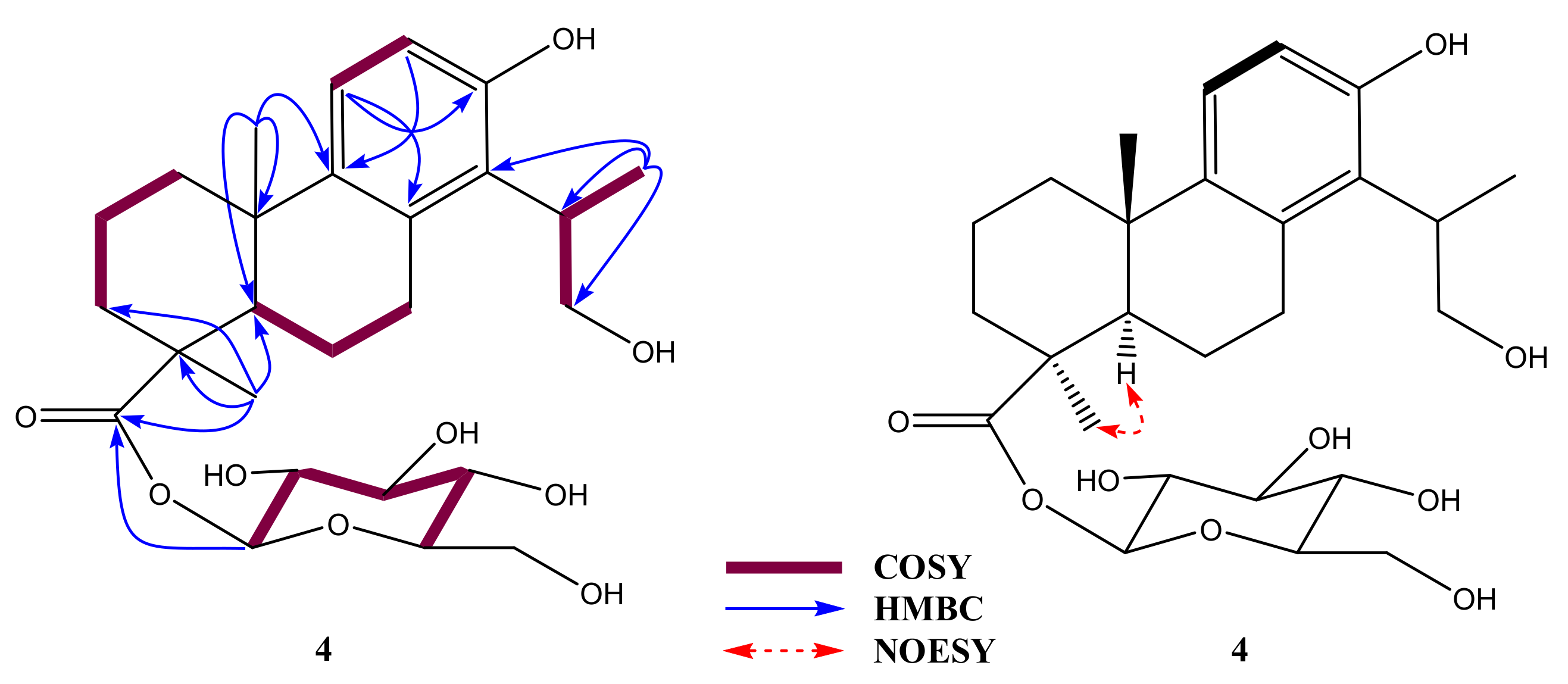
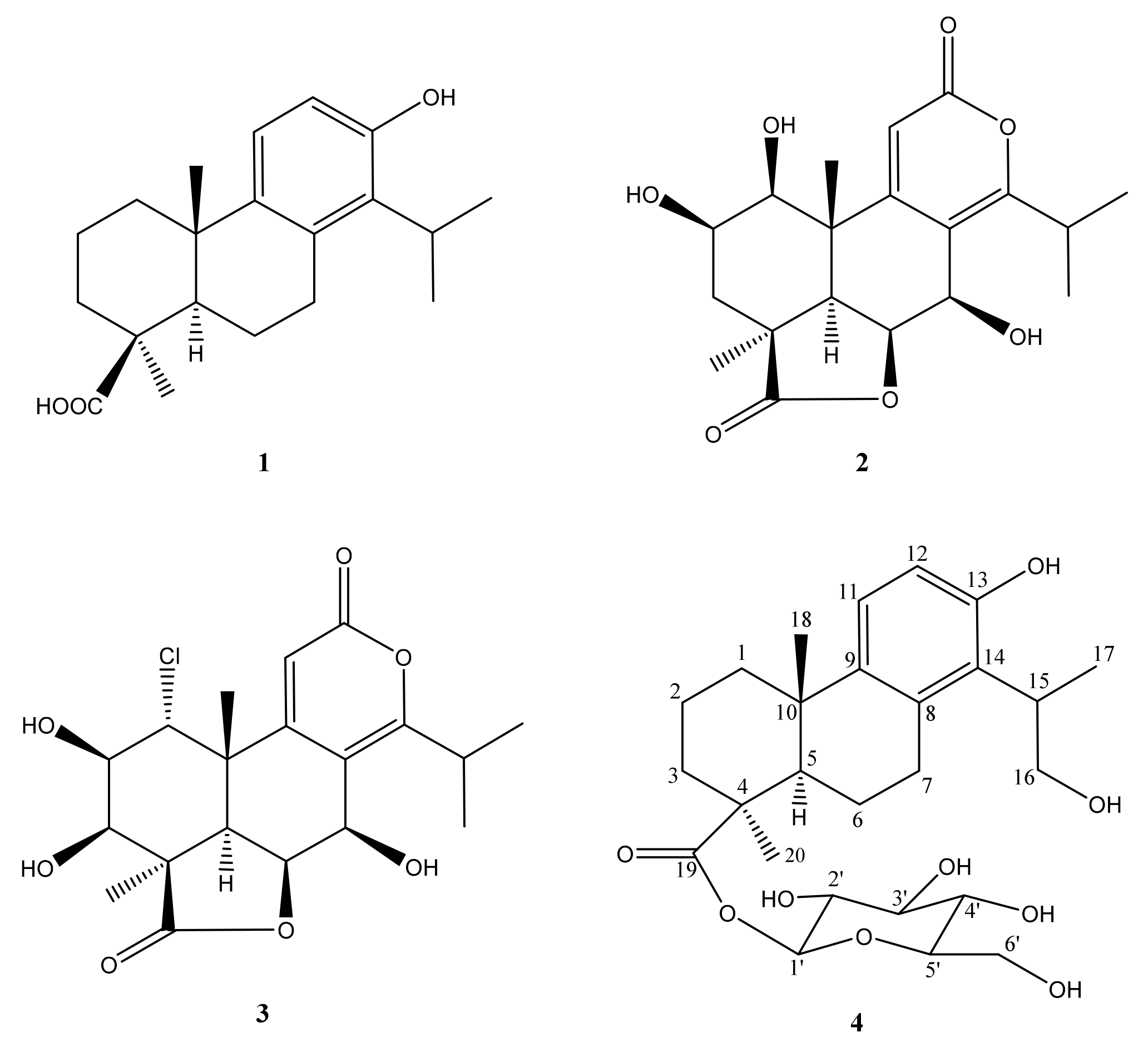

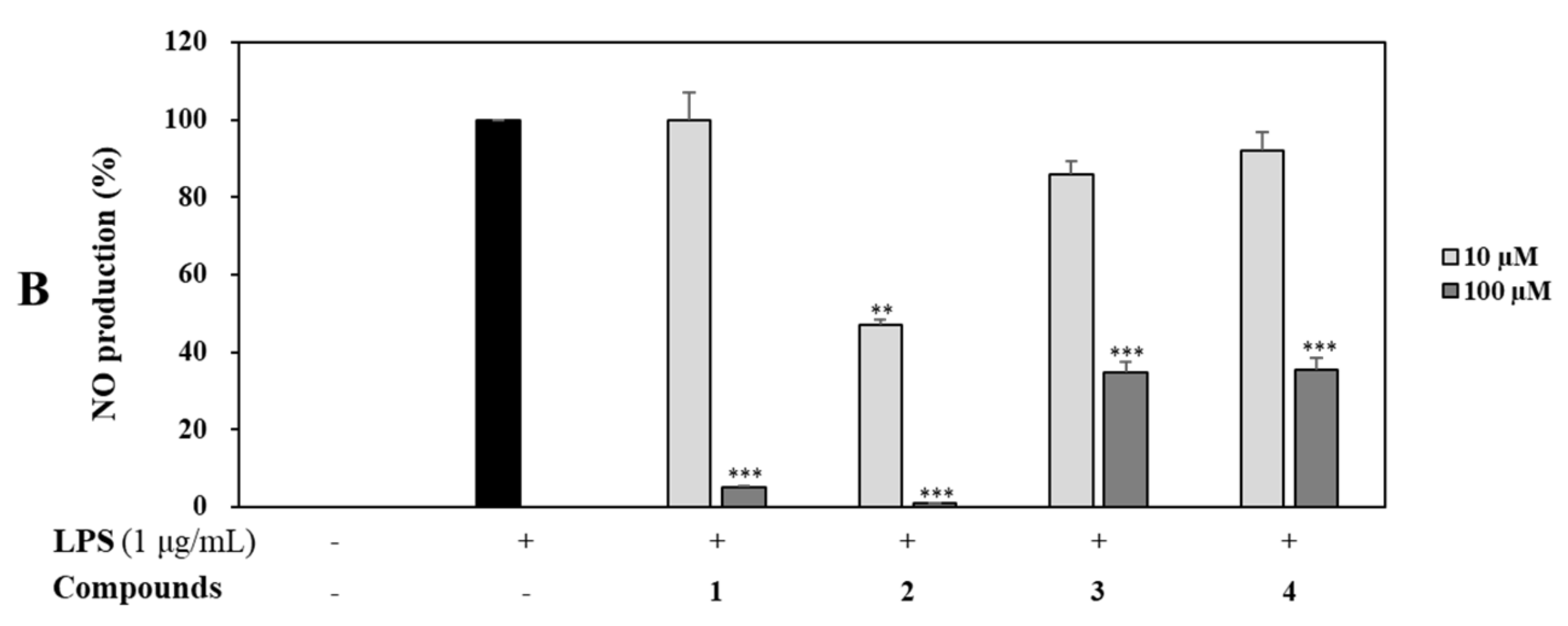


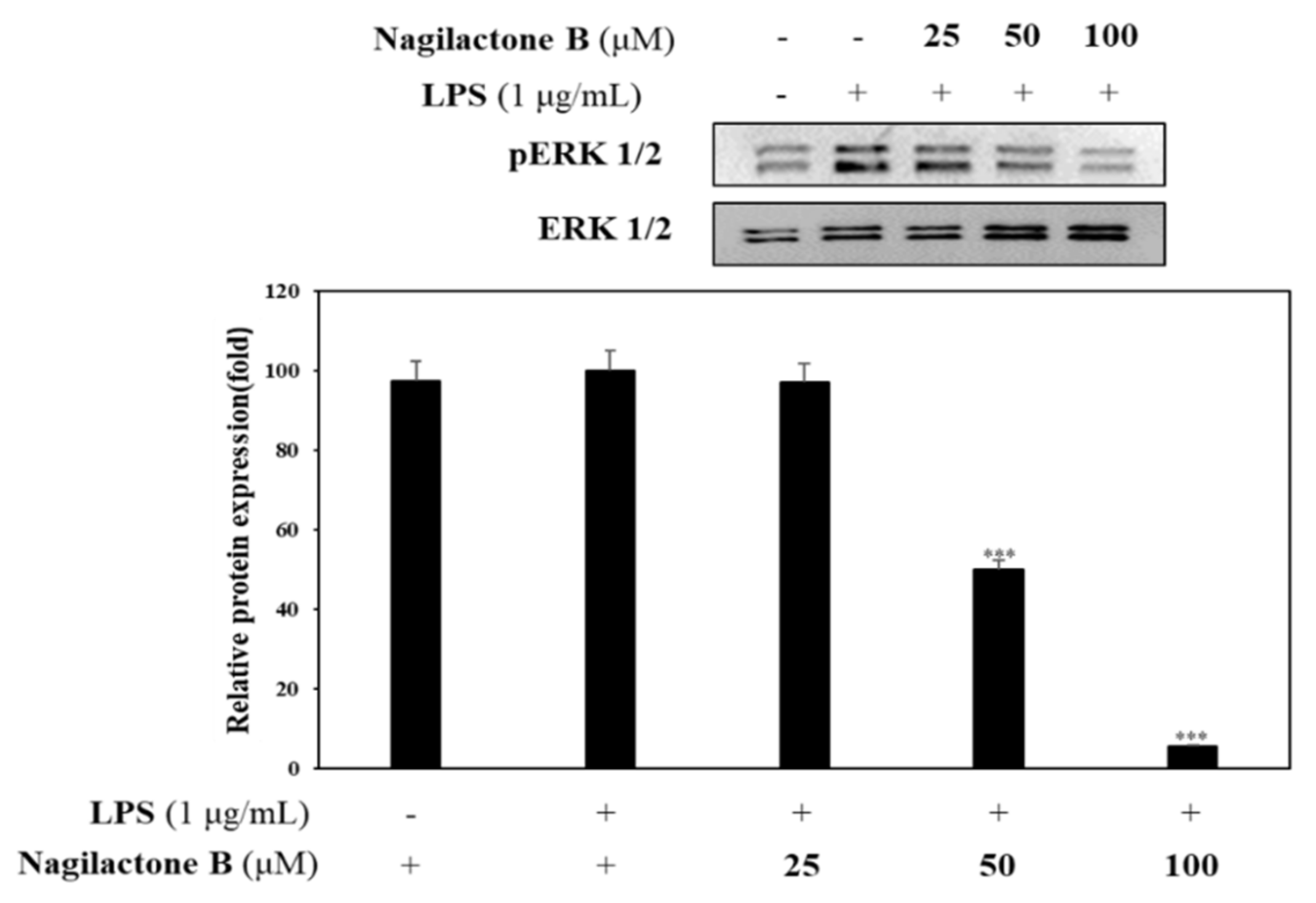
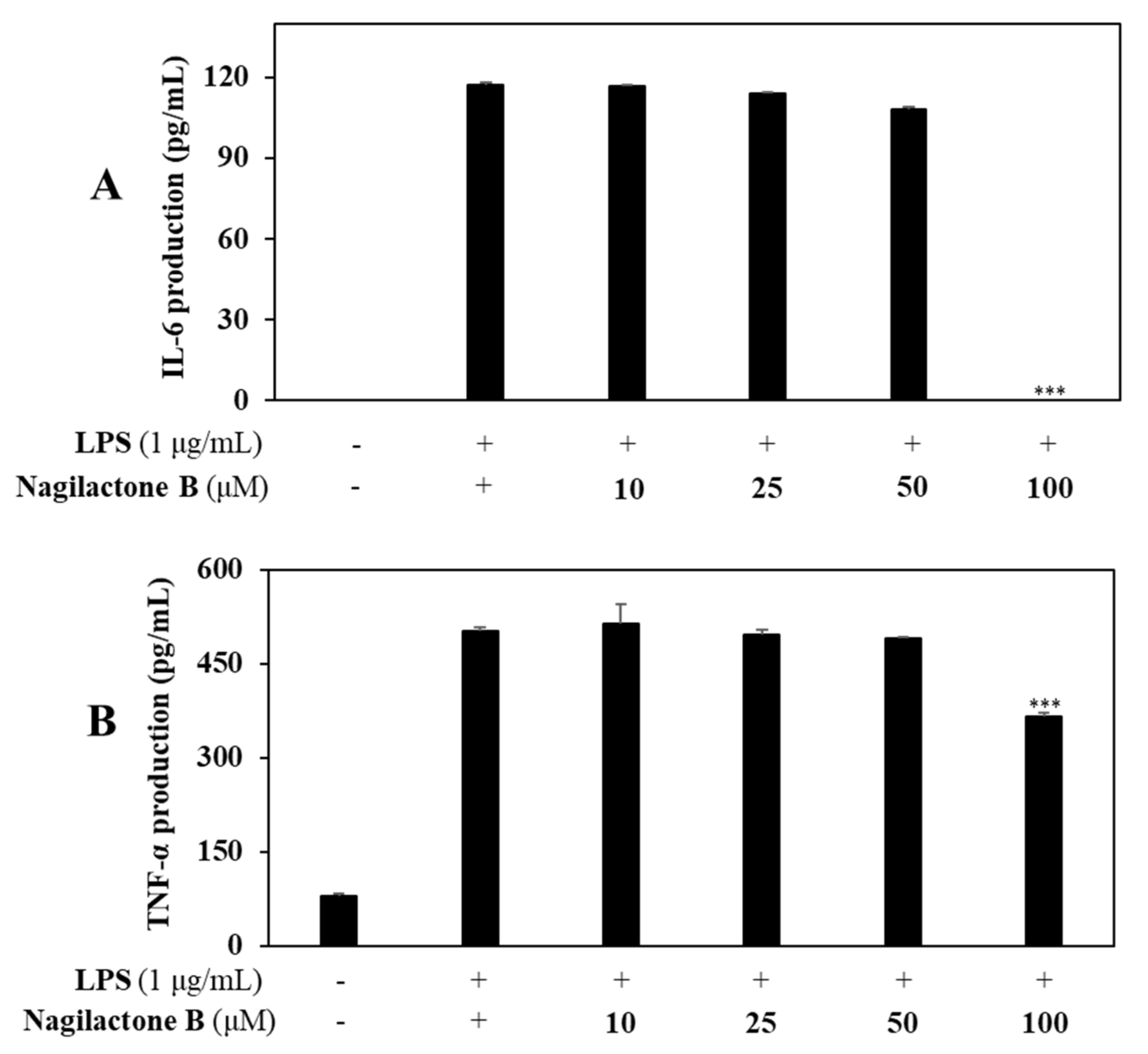
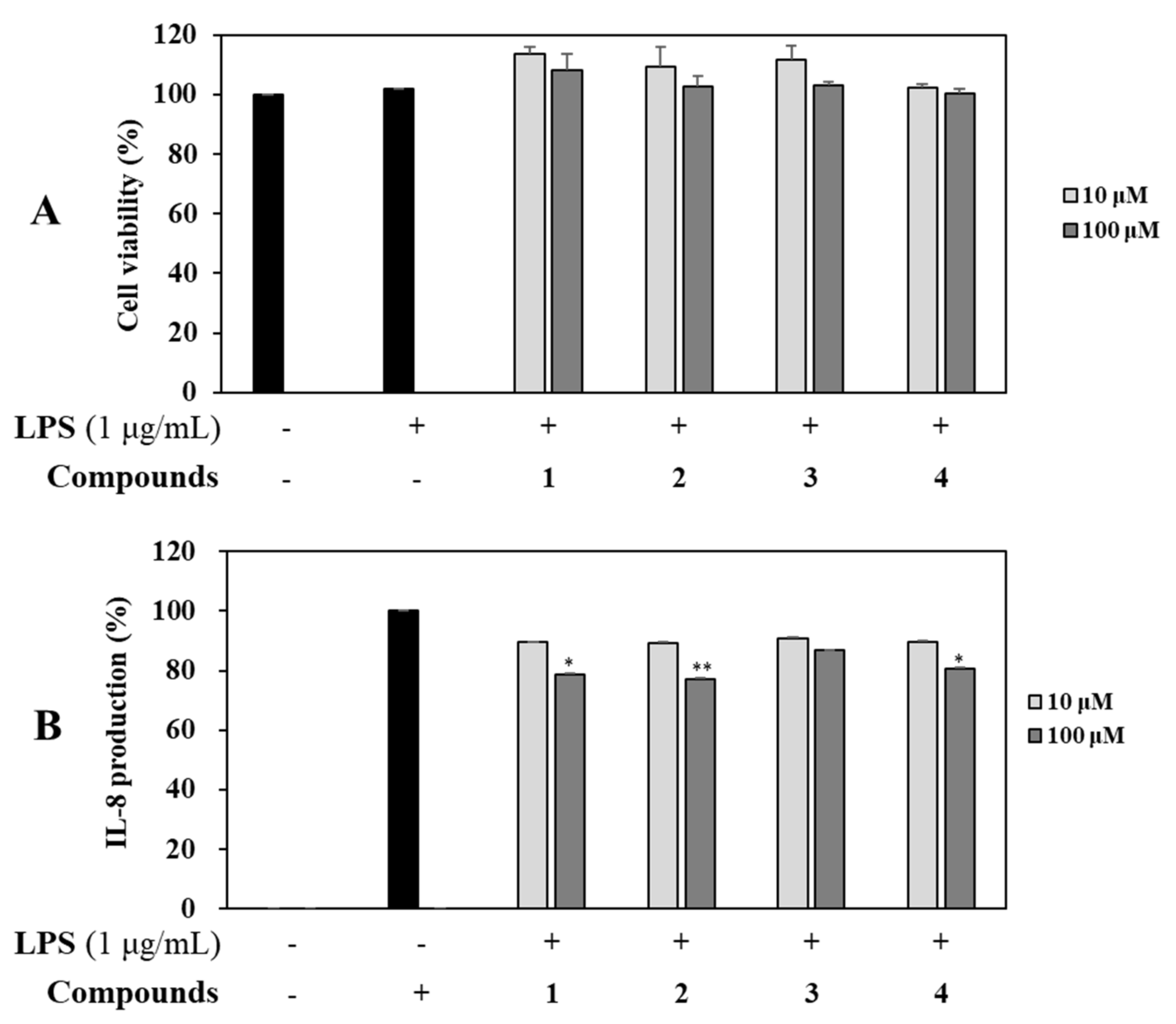
| Parts | DPPH (IC50, μg/mL) | ABTS (IC50, μg/mL) |
|---|---|---|
| Leaves extract | 24.7 | 36.4 |
| Twigs extract | 58.2 | 36.2 |
| Vitamin C * | 24.8 | - |
| BHT * | 101.4 | 34.1 |
| No. | δH (mult., J in Hz) a | δCb |
|---|---|---|
| 1 | 1.20 * 2.14 (m) | 40.1, CH2 |
| 2 | 1.06 (d, 6.6) 2.10 (m) | 36.8, CH2 |
| 3 | 1.47 * 1.95 (m) | 36.8, CH2 |
| 4 | - | 43.4, C |
| 5 | 1.41 (d, 12.4) | 51.6, CH |
| 6 | 1.85 (dd, 4.8, 12.6) 2.95 (dd, 4.2, 16.5) | 33.1, CH2 |
| 7 | 2.50 * | 40.1, CH2 |
| 8 | - | 134.0, C |
| 9 | - | 138.9, C |
| 10 | - | 37.9 |
| 11 | 6.92 (d, 8.6) | 124.0, CH |
| 12 | 6.54 (d, 8.6) | 114.3, CH |
| 13 | - | 153.3, C |
| 14 | - | 127.3, C |
| 15 | 3.09 (m) | 35.7, CH |
| 16 | 3.68 (m) | 64.5, CH2 |
| 17 | 1.19 (d, 6.9) | 15.1, CH3 |
| 18 | 1.24 (s) | 28.0, CH3 |
| 19 | - | 175.3, C |
| 20 | 0.99 (s) | 23.5, CH3 |
| OGlc | – | |
| 1’ | 5.34 (d, 8.0) | 93.9, CH |
| 2’ | 3.12 * | 72.6, CH |
| 3’ | 3.20 (m) | 76.7, CH |
| 4’ | 3.13 * | 69.6, CH |
| 5’ | 3.13 * | 77.6, CH |
| 6’ | 3.44 * 3.59 (dd, 4.1, 11.1) | 60.7, CH2 |
Publisher’s Note: MDPI stays neutral with regard to jurisdictional claims in published maps and institutional affiliations. |
© 2021 by the authors. Licensee MDPI, Basel, Switzerland. This article is an open access article distributed under the terms and conditions of the Creative Commons Attribution (CC BY) license (https://creativecommons.org/licenses/by/4.0/).
Share and Cite
Kim, C.; Le, D.; Lee, M. Diterpenoids Isolated from Podocarpus macrophyllus Inhibited the Inflammatory Mediators in LPS-Induced HT-29 and RAW 264.7 Cells. Molecules 2021, 26, 4326. https://doi.org/10.3390/molecules26144326
Kim C, Le D, Lee M. Diterpenoids Isolated from Podocarpus macrophyllus Inhibited the Inflammatory Mediators in LPS-Induced HT-29 and RAW 264.7 Cells. Molecules. 2021; 26(14):4326. https://doi.org/10.3390/molecules26144326
Chicago/Turabian StyleKim, ChoEen, DucDat Le, and Mina Lee. 2021. "Diterpenoids Isolated from Podocarpus macrophyllus Inhibited the Inflammatory Mediators in LPS-Induced HT-29 and RAW 264.7 Cells" Molecules 26, no. 14: 4326. https://doi.org/10.3390/molecules26144326
APA StyleKim, C., Le, D., & Lee, M. (2021). Diterpenoids Isolated from Podocarpus macrophyllus Inhibited the Inflammatory Mediators in LPS-Induced HT-29 and RAW 264.7 Cells. Molecules, 26(14), 4326. https://doi.org/10.3390/molecules26144326






